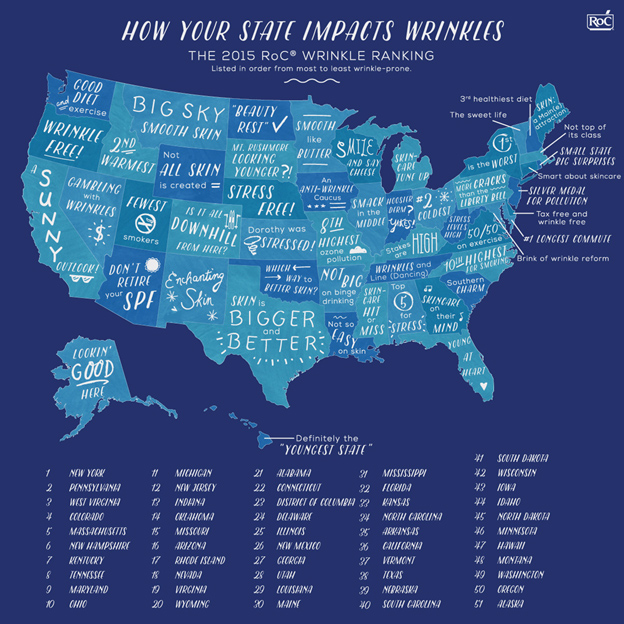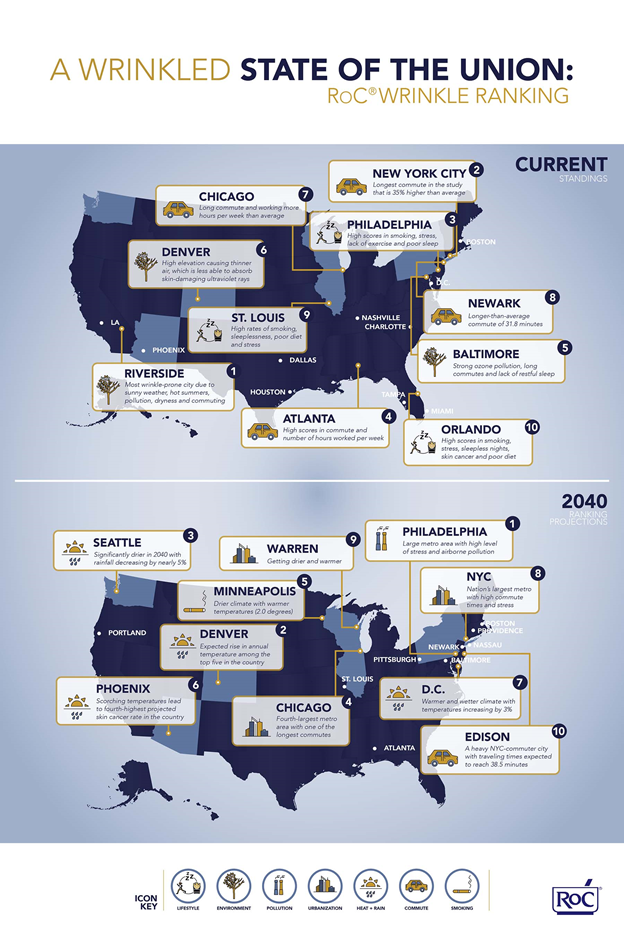![]()
Skincare, maker of topical anti-aging skin care products, partners with ![]() , an analyzer of American city demographics, to produce a yearly ranking of US cities with respect to skin aging and wrinkling. In their analyses the top 5 factors contributing to skin aging/wrinkling are low winter temperatures, extreme weather temperatures, commuter times, sunny days (UV exposure), and elevation. Other contributors are stressful living, dry heat, ozone pollution, sleep deprivation and smoking rates. Although UVB is blocked by glass up to 72% of the UVA radiation of the sun, that which damages and ages the skin, still penetrates ordinary glass. So those with long commutes have significant sun exposure. The risks for skin wrinkles obviously overlaps with skin cancer risks. In 2015 New York was the most wrinkle prone and Alaska was the least most wrinkle prone state. California came in at 36th , Texas at 38th and Florida at 32nd.
, an analyzer of American city demographics, to produce a yearly ranking of US cities with respect to skin aging and wrinkling. In their analyses the top 5 factors contributing to skin aging/wrinkling are low winter temperatures, extreme weather temperatures, commuter times, sunny days (UV exposure), and elevation. Other contributors are stressful living, dry heat, ozone pollution, sleep deprivation and smoking rates. Although UVB is blocked by glass up to 72% of the UVA radiation of the sun, that which damages and ages the skin, still penetrates ordinary glass. So those with long commutes have significant sun exposure. The risks for skin wrinkles obviously overlaps with skin cancer risks. In 2015 New York was the most wrinkle prone and Alaska was the least most wrinkle prone state. California came in at 36th , Texas at 38th and Florida at 32nd.
Their 2014 Wrinkle Risk rankings by city from worst to best (smaller number is more wrinkle prone) of the 50 Largest U.S. Metro Areas were:
1. Riverside-San Bernardino-Ontario, California
2. New York, New York
3. Philadelphia, Pennsylvania
4. Atlanta-Sandy Springs-Marietta, Georgia
5. Baltimore-Towson, Maryland
6. Denver-Aurora, Colorado
7. Chicago-Naperville-Arlington Heights, Illinois
8. Newark, New Jersey-Pennsylvania
9. St. Louis, Missouri-Illinois
10. Orlando-Kissimmee, Florida
11. Washington-Arlington-Alexandria, District of Columbia-Virginia-Maryland-West Virginia
12. Nashville-Davidson-Murfreesboro-Franklin, Tennessee
13. Tampa-St. Petersburg-Clearwater, Florida
14. Miami-Miami Beach-Kendall, Florida
15. Houston-Sugar Land-Baytown, Texas
16. Los Angeles-Long Beach-Glendale, California
17. Charlotte-Gastonia-Concord, North Carolina-South Carolina
18. Dallas-Plano-Irving, Texas
19. Phoenix-Mesa-Scottsdale, Arizona
20. Warren, Michigan
21. Edison, New Jersey
22. Indianapolis-Carmel, Indiana
23. Fort Worth-Arlington, Texas
24. Boston-Quincy, Massachusetts
25. Oakland-Hayward-Berkeley, California
26. Las Vegas-Paradise, Nevada
27. Nassau County-Suffolk County, New York
28. Detroit-Dearborn-Livonia, Michigan
29. Pittsburgh, Pennsylvania
30. Cincinnati-Middletown, Ohio-Kentucky-Indiana
31. Fort Lauderdale-Pompano Beach-Deerfield Beach, Florida
32. Providence-New Bedford-Fall River, Rhode Island-Massachusetts
33. Cambridge-Newton-Framingham, Massachusetts
34. Jacksonville, Florida
35. Austin-Round Rock, Texas
36. Sacramento-Arden-Arcade-Roseville, California
37. Seattle-Bellevue-Everett, Washington
38. Kansas City, Missouri-Kansas
39. Columbus, Ohio
40. Milwaukee-Waukesha-West Allis, Wisconsin
41. San Antonio, Texas
42. Virginia Beach-Norfolk-Newport News, Virginia-North Carolina
43. San Francisco-Redwood City-South San Francisco, California
44. Cleveland-Elyria-Mentor, Ohio
45. Portland-Vancouver-Beaverton, Oregon-Washington
46. West Palm Beach-Boca Raton-Delray Beach, Florida
47. San Jose-Sunnyvale-Santa Clara, California
48. Santa Ana, California
49. Minneapolis-St. Paul-Bloomington, Minnesota-Wisconsin
50. San Diego-Carlsbad-San Marcos, California
Riverside and San Diego are only two hours apart, but on opposite ends of the Wrinkle Ranking scale. Because Riverside has an above average number of hot, dry, sunny days with a lengthy commute (14% higher than average), while San Diego has a mild Pacific climate. New York residents have the longest commute (35% higher than average), are exposed to the top third of ozone and particulate pollution and have the third-highest number of sleepless nights. Denver earned the sixth position for scoring highest in the Environment category. Mile-High City’s residents have one of the highest skin cancer rates due in part to the thin air which is less able to absorb skin-damaging UV rays. It also has the second-lowest humidty and the 6th-highest level of ozone pollution. Chicago metro area earns its #7 spot with long commutes (31.1 minutes each way, average is 27.4) and working more hours per week than average. Chicago also ranks high for stress (with an unemployment rate of 9.7%, average is 7.5%, plus alcohol use is high with 15.1 drinks per month reported, compared to an average of 12.7 drinks), sleepless nights (8.0 nights per month with poor sleep, average is 7.7), extreme temperatures and particulate pollution is in the top 20%.
For 2016 the top (worst) ten wrinkle rankings were the same as 2014. Predictions for 2040 show a different ranking.








Join the Discussion!